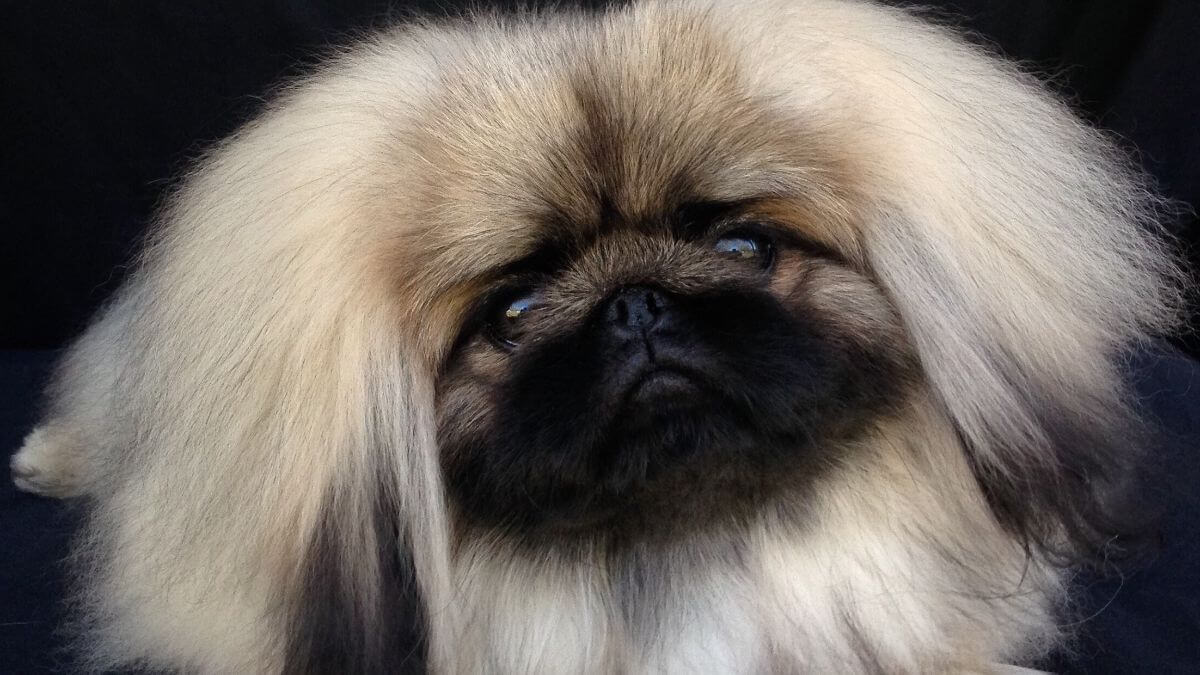


Home » Pekingese in the Ring

This article was originally published in Showsight Magazine, February 2015 issue.
Pekingese in the ring” is a familiar call from the steward indicating it is time to enter the ring in catalog order and set the dog up for a preliminary look and evaluation by the judge. The first thing the judge will look at is the overall balance and outline of every dog. The Pekingese is a well-balanced compact dog of Chinese origin with a heavy front and lighter hindquarters. Its temperament is one of directness, independence and individuality. Its image is lion-like, implying courage, dignity and self-esteem rather than daintiness or delicacy. Following this preliminary look at all the exhibits, the judge will ask the dogs to go around the ring to the table and put the first dog on the table for examination. If the show is inside, it’s important to walk the dog on the mat at all times—if the show is outside, the judge will indicate whether to walk in a large or small circle around to the table. “Examine on the table, judge on the ground” is a familiar phrase referring to toy dogs or any breed that is examined on the table.
In fact, the judge should return the dog to the table if a later examination is required or if a comparison to another dog is necessary. AKC has allowed the judge to compare two dogs at a time on the table. The judge will first consider the profile of the dog on the table from the center of the ring and then proceed to the front of the dog. While considering the profile, overall balance is of utmost importance. The head is large in proportion to the body which is slightly longer than tall. The overall outline is an approximate ratio of 3 high to 5 long when measured from the forechest to the buttocks. The well-known scholar of the breed, Nigel Aubrey Jones stated, “Correct body shape is vital if correct balance and movement are to be achieved.” Because the Pekingese is a heavy-coated dog, it is essential to examine beneath the coat, but keep in mind it is a toy dog so gentle light hands are required during the examination. The judge should approach the front of the dog on the table and place their hands behind the ears cupping them to frame the face.
The head of a Pekingese is one of the hallmarks of the breed—a large head in proportion to the body is essential. Nigel Aubrey Jones said, “The Pekingese head is the stamp of the breed.” The head should be massive, broad with a flat topskull combined with wide-set, large dark eyes and a shallow rectangular, envelope-shaped head. The type of envelope shape required here is a normal business size envelope—not a square birthday card envelope. This is important to remember because a Pekingese should NOT have a square head. The judge should be able to see a line drawn horizontally over the top of the broad short black nose that intersects slightly above the center of the eyes. The wrinkle separates the upper and lower areas of the face and frames the nose. The ears are set on the front corners with long heavy fringing that frames the face. The muzzle and the mouth should be broad with an undershot lower jaw. Since dentition is not part of the Pekingese standard, it is not necessary to open a Pekingese mouth.
Pekingese are not trained or used to having their mouth pried open. If the judge suspects a wry mouth, ask the exhibitor to show the bite as the teeth or tongue must not show when the mouth is closed. The judge will then gently move their hands down the short thick neck and feel the well-laid back shoulders and tight elbows as well as the short heavy-boned forelegs that are moderately bowed between the pastern and elbow. This is accompanied by a broad chest with well-sprung ribs slung between the forelegs. The toes on the forefeet are slightly turned out. Moving around to the side of the table, the judge will examine the body and topline and determine that the topline is straight and level and with both hands will feel the pear shape and lighter loin with lighter-boned hindquarters and moderate angulation. The tail should be high-set with long profuse fringing. In examining the rear, the judge may move to the end of the table to determine the rear legs are reasonably close and parallel with feet pointing straight ahead.
The hind legs are lighter than the front but are firm with moderate angulation. Because the Pekingese has a long, coarse-textured, straight, stand-off outer coat, with thick, soft undercoat, it is necessary to gently hand examine beneath the coat to determine the correct body shape. Because the standard is very specific in stating that the Pekingese, when lifted is surprisingly heavy for its size, it is necessary to determine this by properly lifting the dog. Lifting the dog two inches off the table will determine this without causing undue stress to the dog. The correct way to lift the dog is to wrap your hand and forearm around the dog behind the shoulders and under the body. The other hand and arm must support the chest between the front legs. Slowly and gently lift the dog two inches above the table. Since the majority of the weight should be in the chest, it is necessary to have your hand support the chest between the front legs. Remember always that the Pekingese should feel solid and heavy for its size.
Remember—the Pekingese is not lifted to ascertain whether it is within the permissible weight of 14 pounds per the breed standard. The AKC judging policy is very specific in that the only way a judge may determine the weight of the dog is through the use of an AKC approved scale. If the judge suspects the dog is over 14 pounds, the correct procedure is to call for the scales. Correct movement on the Pekingese is only possible when the body is correct. The characteristic movement is unhurried, dignified, free and strong with a slight roll over the shoulders. The motion is smooth and effortless and is as free as possible from bouncing, prancing or jarring.
The rolling gait results from a combination of the bowed forelegs, well-laid back shoulders, full broad chest and narrow light rear, all of which produce adequate reach and moderate drive. Rose Marie Katz, one of the prominent American breeder-exhibitors of Pekingese in the 1950s and 60s said, “The Pekingese dog should be judged as a whole. It must present a picture of balance and type. It must be evaluated for its good points rather than torn apart for its faults. In evaluating a Pekingese, one must keep in mind that it is a toy dog of great substance and character for its small size.”